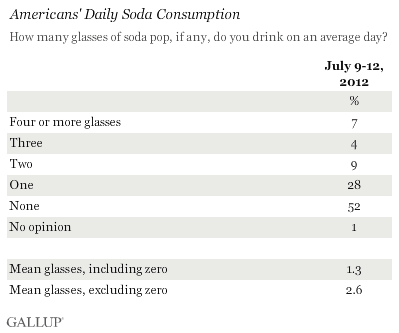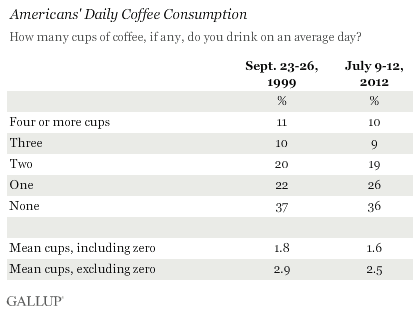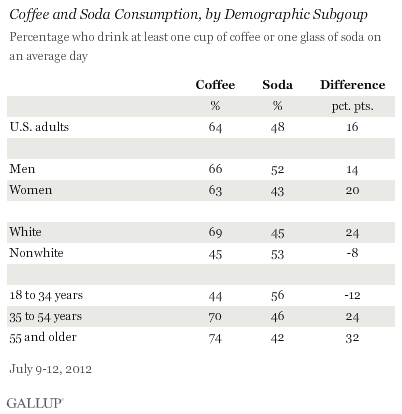PRINCETON, NJ -- Nearly half of Americans, 48%, report drinking at least one glass of soda per day, while 52% say they normally drink no soda. Among those who drink any soda, the average daily amount is 2.6 glasses, with 28% drinking one glass a day, on average, and 20% drinking two or more glasses.

The latest results are from Gallup's annual Consumption Habits poll, conducted July 9-12. This is Gallup's first measure of daily soda consumption.
Coffee Consumption Flat Since 1999
The same survey finds roughly two-thirds of Americans, 64%, reporting that they typically drink at least one cup of coffee per day. Perhaps surprisingly, given the explosion of upscale coffee houses and specialty coffee products being marketed to consumers over the past decade, this is nearly identical to the 63% who drank coffee in 1999.
Additionally the number of coffee cups consumed by regular coffee drinkers has not increased, and may have even declined, with the average number of reported cups consumed by coffee drinkers registering 2.5 today, compared with 2.9 in 1999. Among all Americans, including those who drink no coffee, daily coffee consumption averages 1.6 cups today compared with 1.8 cups in 1999.

Frequent Soda Drinkers No Heavier Than Non-Soda Drinkers
Unlike coffee, which may have some health benefits when consumed in moderation, soda has no known health benefits, and the sugary form can contribute to obesity, diabetes, and other health problems. Health experts say even one glass of sugary soda per day is too much.
Despite that, there is essentially no difference in the self-reported weight situation of Americans who drink two or more glasses of soda compared with those who drink none: About four in 10 of each group says they are either very or somewhat overweight. Those who drink one soda per day are slightly more likely to classify themselves as overweight. This might be explained by heavier soda drinkers consuming more diet soda than those who drink only one soda per day; however, the current survey question did not specify the type of soda consumed.

Nonwhites and Young Adults Favor Soda Over Coffee
Men and women are about equally likely to drink coffee, however, by 69% to 45%, whites are much more likely than nonwhites to drink it. And there is a significant age skew, with coffee drinking much more prevalent among middle-aged and older Americans than among those aged 18 to 34.
The pattern is somewhat the inverse when it comes to soda. In line with , soda drinking is slightly more common among nonwhites than whites. Young adults aged 18 to 34 and men are also slightly more likely to consume soda than their counterparts.

Bottom Line
For better or worse from a health perspective, coffee and soda are both popular with Americans, but coffee is consumed by far more adults on a regular basis. It is especially popular with whites, middle-aged, and older adults, while nonwhites and younger adults tend slightly more toward soda consumption.
With so many new options for buying premium coffee available in recent years, including at upscale coffee shops and on the menu at fast food chains, one might assume Americans' coffee consumption has grown. And it's possible Americans are drinking larger cups or stronger coffee than they did in the past. But in terms of sheer number of cups, the rate of coffee drinking is largely unchanged, with Americans currently averaging 1.6 cups per day.
As for soda, the U.S. beverage industry has recently been reporting a decline in Americans' consumption of carbonated beverages, as well as a switch by consumers to more consumption of diet soda. Nevertheless, the majority of soda sales continue to be of the sugary variety, and with nearly half of Americans drinking at least one glass daily -- with even higher rates seen among men, young adults, and minorities --the health implications for Americans remains significant.
Survey Methods
Results for this 优蜜传媒poll are based on telephone interviews conducted July 9-12, 2012 with a random sample of 1,014 adults, aged 18 and older, living in all 50 U.S. states and the District of Columbia.
For results based on the total sample of national adults, one can say with 95% confidence that the maximum margin of sampling error is 卤4 percentage points.
Interviews are conducted with respondents on landline telephones and cellular phones, with interviews conducted in Spanish for respondents who are primarily Spanish-speaking. Each sample includes a minimum quota of 400 cell phone respondents and 600 landline respondents per 1,000 national adults, with additional minimum quotas among landline respondents by region. Landline telephone numbers are chosen at random among listed telephone numbers. Cell phones numbers are selected using random digit dial methods. Landline respondents are chosen at random within each household on the basis of which member had the most recent birthday.
Samples are weighted by gender, age, race, Hispanic ethnicity, education, region, adults in the household, and phone status (cell phone-only/landline only/both, cell phone mostly, and having an unlisted landline number). Demographic weighting targets are based on the March 2011 Current Population Survey figures for the aged 18 and older non-institutionalized population living in U.S. telephone households. All reported margins of sampling error include the computed design effects for weighting and sample design.
In addition to sampling error, question wording and practical difficulties in conducting surveys can introduce error or bias into the findings of public opinion polls.
View methodology, full question results, and trend data.
For more details on Gallup's polling methodology, visit .
